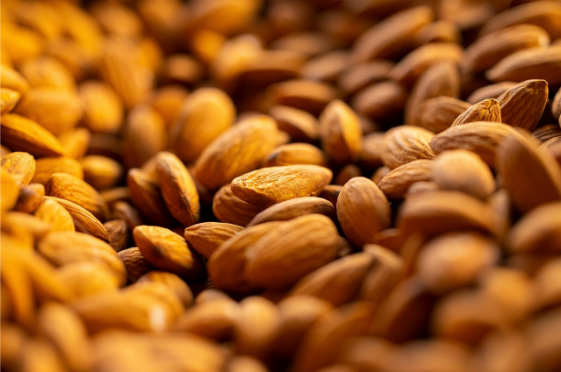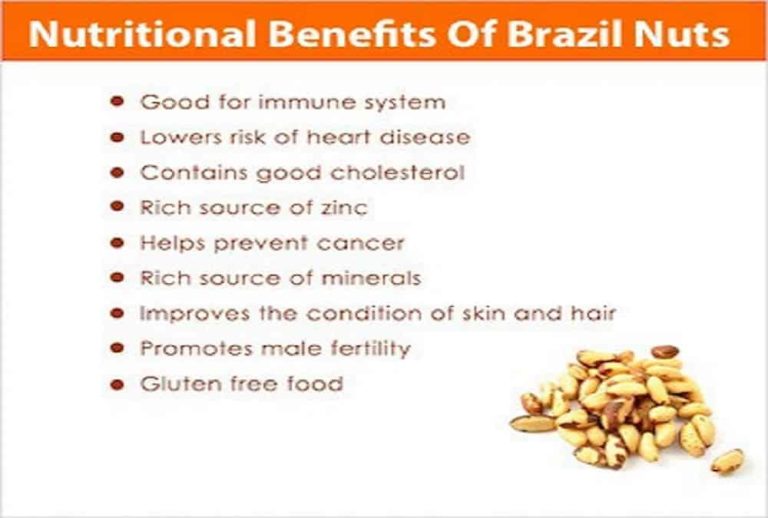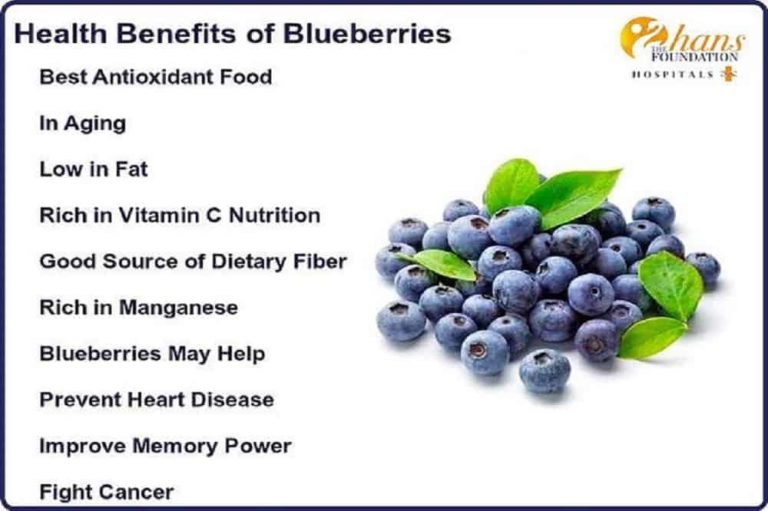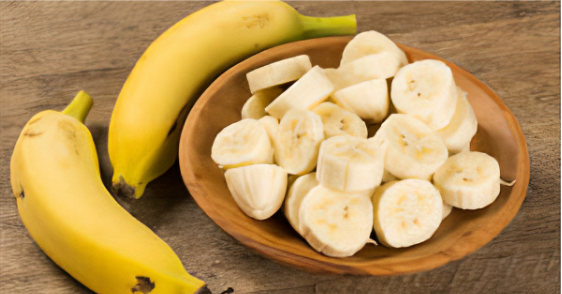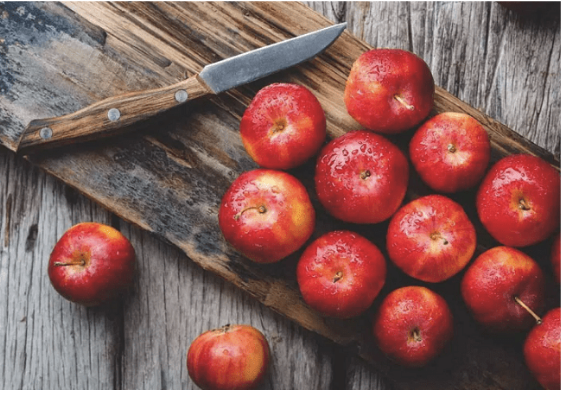Your cart is currently empty!
Human Nutritional Needs
Human needs are far more than physical requirements. A distinguished biologist, Dan Jantzen, said human needs are “food, shelter, and sex.” If only it were that simple. Food is the most complicated of the three. What we need from our food is a vast range of nutrients. We also use food to provide feelings of security, control, communication, and nurturance. We need air and water, which are not strictly nutrition but are closely related.
If active, the average “reference human” (in the human nutritional needs literature, a 72-kilogram or 150-pound adult) needs about 3,000 calories daily and a large but variable amount of water. Around 1,600 of those calories support basal metabolic activities. Those activities include heartbeat, digestion, and the 400 calories needed for nervous system performance.
Research On Calories Needed For Physical Activity
The rest of our calories go into physical activity. Some adults get by for long periods (famines or hungry seasons) on little more than 1600 calories. In the 1940s and 1950s, Audrey Richards describes people virtually hibernating during the dry season in the starved lands of interior Zambia. Metabolism slows, activity ceases, and people lie down until food arrives.
At the other extreme, lumberjacks in the old hand-logging days in the North Woods of Finland or British Columbia needed 5,000-6,000 calories. Increased consumption of 7,500 calories per day has been reported. Chill temperatures, as well as heavy activity, force the body to burn more. Just as they can adapt to famine, humans can adapt to chronic cold by increasing calorie consumption. They also adapt to high food intake levels by using the food less efficiently. Harvest vitamins from the intake and let the rest go poorly digested.
Any activity takes some calories; reading and watching television require 70-90 per hour, housework about 170, sex about 100, and serious hard work about 400 per hour. Nervous, fidgeting people may use a few hundred calories daily more than tranquil people. Conversely, some people use fewer calories because they metabolize more efficiently than others.
How The Body Uses Calories To Burn
Muscle uses 30-50 calories per pound for basal metabolic functions. Fat uses only two calories per pound. Extreme dieting wastes muscle, and restoring body weight after such loss often takes the form of fat. In calorie deficiency, fats are burned first, then less necessary muscles and tissues, then vital organs; the brain is most spared. The stomach and gut shrink to adapt to long deprivation, making it necessary to feed famine victims when saving them carefully. Human nutritional needs have let us survive despite surprising gut and other tissue loss.
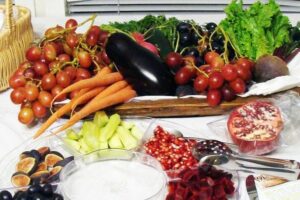
Caloric Sources
Worldwide, most calories are from carbohydrates. In fact, outside of a few hunting societies, almost all human groups get most of their calories from that source. Many hunter-gatherer societies, and some postindustrial societies like the United States, get as many calories from fats and oils. The great staples of world commerce, such as wheat, maize, potatoes, rice, and sugar, are the majority of sources of carbohydrates.
Carbohydrates are, however, needed only in small amounts. Complex carbohydrates are better for human nutritional needs and are healthier for human bodies than simple ones. Simple sugars and highly refined starches are examples of simple carbohydrates
Carbohydrates are carbon chains with the general formula CHO. The standard basic one that we use for ordinary metabolism is glucose, C6H1206. Some other simple sugars have the same empirical formula but different structures. Fructose is one structural form. Glucose is the dextrorotatory form. The human body converts fructose and galactose to glucose for metabolic purposes.

Sugar Arrives In Both White And Brown Colors
Short-chain compound sugars include sucrose-ordinary white sugar. It breaks down easily into a molecule of glucose and a molecule of fructose. Maltose breaks down into two glucose molecules. Breaking a sugar molecule takes some effort, meaning that even these simple compounds are less rapidly digested than simple sugars.
Sugar is associated with everything from diabetes to dental cavities, both of which can cause heart disease. Modern advocates for health maintain that sugar is now as damaging to the public as alcohol. Health advocates want it kept entirely out of school lunches. There is also increasing evidence that heavy fructose consumption is worse than sucrose. It produces a very rapid spike in blood sugar followed by a crash, and it has other disadvantages. It is associated with inflammation in the gut and inflames the muscle and tissue. High-fructose corn syrup, widespread in technological foods, is thus under some suspicion as a cause of obesity.
Obesity decreases the effectiveness of the vitamins and minerals in our diet. Obesity hurts our bodies’ ability to satisfy our human nutritional needs.
Lactose
Lactose is broken down by digestion into glucose plus galactose. Human babies are born with the enzyme lactase, which performs this cleavage. However, most humans stop producing this enzyme around 6-10. Thus, most adult humans cannot digest lactose. Like other undigested sugars, it causes diarrhea, flatulence, and, in large quantities, outright sickness. Small amounts of milk are tolerated, and more leads to indigestion. However, Europeans (especially North Europeans) and East Africans have depended on fresh milk for so long that they have evolved the ability to keep producing lactase throughout life.
Presumably, the human nutritional needs of children without lactase did not thrive as fresh dairy products became increasingly vital as staple foods. However, at least some humans can adapt to high-milk diets by continuing to produce lactase when they would not otherwise have.
Dairy Sources Worldwide
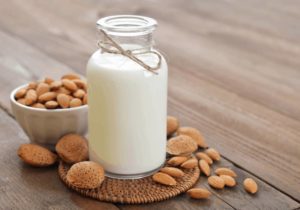
Dairying has been extremely important for thousands of years in the Western world, going back 8,000 years in some places, creating strong selection pressures. East African cattle nomads are even more dependent on fresh milk; some get over 80% of calories from it and have not one but three genes to keep them producing lactase throughout life. Most humans cannot eat fresh dairy foods outside Europe and East Africa. Even in Mediterranean Europe, most cannot. In East and Southeast Asia, virtually all cannot, even after long exposure. But they have learned to make microorganisms do the enzyme work. Fermenting milk into yogurt, cheese, and the like involves the breakdown of lactose by Lactobacillus bacteria.
Yogurt is generally made by L. bulgaricus. (Other Lactobacillus species give us salami, sauerkraut, and sourdough bread.) Thanks to yogurt making and other processing, people in West and Central Asia and the Indian subcontinent depend on dairy foods, even though only 10%-20% of them can digest lactose. Lactobacillus and Lactococcus fermentation also give us cheese, with the odd result that Wisconsin-America’s Cheese Center designated Lactococcus lactis the Wisconsin State Microbe in 2010.
Some Arctic-dwelling humans and some birds, such as starlings, have lost the ability to produce the enzyme sucrase and thus cannot digest ordinary sugar. There are longer-chain sugars, mostly indigestible. Stachyose and raffinose in beans cause indigestion and flatulence associated with beans because we cannot digest them.
Sucrose Is A Longer Chain Carbohydrate
Longer chain carbohydrates (polysaccharides) are starches we can digest by breaking them into glucose. Potato starch is particularly easy to digest and thus can cause a sugar rush in the body. The glycemic index measures how fast this digestion process takes place. Fructose and glucose, absorbed immediately, are at the top, with potato and white rice starch close behind. White flour is also a problem for reaching complete human nutritional needs. Sucrose is farther down. Some foods with high glycemic index are not a problem because there is very little carbohydrate per serving. Carrots are an example. These are said to have a low glycemic load.
Still longer chains include fiber compounds like lignin and cellulose, which higher animals cannot digest. Ruminant mammals, termites, and other creatures have symbiotic microorganisms to do their digestive work. Humans also have gut flora to digest some of these compounds, especially in areas with high-fiber diets. Fiber is extremely good for the gut and may protect against various diseases. Soluble fiber helps with heart disease. Doctors now recommend 25 grams of fiber daily for women and 38 for men. This is true paleolithic diet feeding; getting into a normal contemporary diet is almost impossible. To meet optimal human nutritional needs, eat unprocessed vegetables, grains, beans, or special high-fiber foods like oat bran.
The Difference Between Carbohydrates And Protein
Proteins are carbon-nitrogen structures that are made up of chemically combined amino acids. An amino acid is a carbon atom joined -NH2 (an amine group), -COOH (a carboxylic acid group), a hydrogen atom, and a more complex fourth functional group, a different side chain in each amino acid. Compared to carbohydrates, proteins are difficult for plants to make and digest.
Protein, per se, is not a physical need. We need eight (some say nine) of the amino acids that are the “building blocks” of proteins. Since amino acids do not often occur in nature except in the form of proteins, the term “protein” is used as shorthand for this requirement. The body makes the other fourteen or more amino acids it needs and all its proteins from the basic eight.
When eaten, protein is first broken down by digestion into the component amino acids, then reassembled in the body’s cells into whatever proteins we may need. The “reference human” needs about two ounces of protein daily, about what you get from six ounces of meat or a cup of beans. This “reference human,” recall, is an active, large adult storing supplies for times of stress. Disease, burns, and other major stressors lead to a mass drawdown of bodily protein supplies. A seriously burned individual can starve to death simply because it is difficult to take in enough calories for tissue repair. Superefficient intravenous feeds have been developed to satisfy human nutritional needs during extreme healing.
Amino Acids
The amino acids most commonly deficient in food are lysine and methionine. Grain is usually low in lysine, and beans are high in methionine. A combination of the two (or a high-lysine grain) provides a better amount of nutrition. It has long been noted that almost all cultures that have spent a long time at high population densities have figured out ways to combine beans and grains: khichri (bean-grain mixes) and dal (split lentils or beans) with rice in India, bean curd and rice in China, pasta e fagioli (pasta and bean soup) in Italy, tortillas and beans in Mexico, and so on.
The value of protein to the body is only as great as the value of the most deficient amino acid. Justus Liebig, a nineteenth-century Nutritionist, discovered the Law of the Minimum: If you need to build tissue and have everything except one nutrient, you can’t build the tissue. The least adequately supplied nutrient sets the Liebig limit. Thus, a person getting all her protein from grain may seem to be getting enough protein, but she may be getting only two-thirds as much as she needs. The balance of amino acids in a given food is called the “protein score.” The more perfect the balance of amino acids for human growth and tissue repair, the higher the score. This is a rather arbitrary measure, though the concept is clear enough.
Food Scoring On Human Nutritional Needs
Various authorities score foods in different ways. Usually, human milk, ideal for young humans, is rated 100. Egg white runs around 96. (Sometimes egg white, or even whole egg protein, is scored at the 100 mark, in which case the whole table has to be redone.) Muscle meat runs around 85. Grain and beans are around 65-75; rice is rather high in the score, and soybeans are protein-rich but low in the score. Potatoes have some of the best plant protein, scoring around 75-80. (Different laboratories report different scores and different potato varieties have different scores.) Grain-bean mixes run around 75 or even higher. The belief that vegetable proteins are “incomplete” is a pure myth. The only incomplete proteins (lacking one or more essential amino acids and thus scoring zero) that one meets in everyday life are gelatin and casein-both animal proteins.
Same Ingredients In A Variety Of Qualities
Note that the protein score has nothing to do with the amount of protein in the food. Leaf protein is very high scoring, but most leaves have so little available protein that they are very poor sources for a hungry human, though alfalfa sprouts and other young leaves of protein-rich plants are better. Conversely, beans have low scores but are high enough in total protein to be widely called “the poor man’s meat.”
The body requires fats. More accurately, linoleic and linolenic acids. Usually, people need only trace amounts. The exceptions are women who are pregnant or, above all, lactating. Human milk is quite fatty. Producing it thus requires fat in the diet and, usually, fat stores in the body. A woman’s body is programmed to store about 20 pounds of fat during pregnancy. This reserve is drawn on for lactation. In addition, a lactating woman needs to get about 7% (at least) of her calories directly from fat.
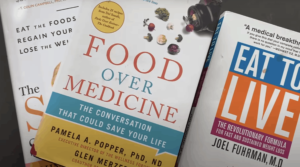
A Look At The Nutrition Of Animal Foods
The popularity of animal foods cross-culturally is explained by the desire for fat rather than protein value. People love fat. Left to themselves, they tend to select exceedingly high-fat diets. Arctic people may get 80% or more of their calories from fat during good times. Perhaps it is only cost and habit that keep other cultures from joining some Americans, Greeks, Inuit, and Northwest Coast Indians in using fat as a main staple. Animal fats are notoriously bad for the circulatory system. Especially if one is male, genetically prone to making a lot of “bad cholesterol,” and older.
Fats are esters (“salts”) of fatty acids. Fatty acids are made up of CHO chains, like carbohydrates, but with a -COOH tail at one end. Digestion breaks fatty acids into the component ions, with lipase being the key enzyme. Fatty acids can be saturated (all carbon atoms in the fatty acid chain are bonded to four other atoms), monounsaturated (one of the carbon atoms in the fatty acid chain is double bonded to another carbon atom in the chain so that it has only three other atoms attached to it), and polyunsaturated (several of the carbon atoms in the fatty acid chain are double bonded). Saturated fatty acids include palmitic and myristic acids, which are considered bad for satisfying human nutritional needs, lauric acid, and stearic acid.
Monounsaturated Oils In Fast Food
Monounsaturated fatty acids include oleic (the major one in olive oil) and several other fatty acids. Polyunsaturated ones are primarily linoleic, linolenic, and derivatives thereof. Linoleic is one of a class of closely related “omega-6 fatty acids” (two double-bonded carbon atoms). Linolenic and its relatives, “omega-3 fatty acids”, are associated with very low heart disease rates. The mysterious name refers to how far back the last unsaturated bond is from the molecule’s end (the omega carbon).
On the whole, polyunsaturates are found in plant foods, but omega-3’s abound in the marine food chain and thus in marine animal fats-being especially common in salmon, mackerel, herring, and similar fish and in the marine mammals that eat them. Most plant polyunsaturates are omega-6, but omega-3s are common in flaxseed, walnut, and evening primrose seed oils. Linoleic, linolenic, and possibly arachidonic acids (another polyunsaturate) are necessary for humans. Hunters and gatherers got more omega-3 than most of us do today and thus had a better balance in their diets, presumably with good effects on health.
Natural Nut Oils Are Higher In Quality Oil
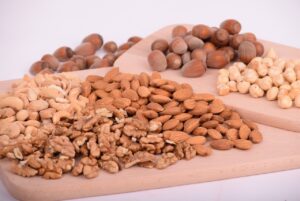
Consumption of walnuts, almonds, and pistachios is associated with lower blood cholesterol and, thus, lower circulatory-system disease because of the omega-3s. The dangers of a high-fat diet are due to overconsumption of saturated fatty acids and perhaps a high ratio of linoleic to linolenic acid among the unsaturated ones. With more linolenic acid, protective and compensating mechanisms kick in. Heart disease rates are low among even the most assiduous marine-animal-fat eaters- the Inuit.
Eating linolenic acid alone does not protect against heart disease. One must eat it and/or its metabolites in natural foods. Omega-6 acids are cleaved by enzymes into several chemicals, including prostaglandins, which are associated with inflammation. Omega-3s are cleaved into complementary compounds that balance these out. A balance appears necessary; too much omega-6 may mean too much inflammation, but too much omega-3 might be bad, too (it is such a rare condition that no one seems to know).
Good Cholesterol And Bad Cholesterol
The ratio of “good cholesterol” (high-density lipids, or HDL) to “bad cholesterol” (low-density lipids, or LDL) is also affected by this. It depends on total consumption of unsaturated fats instead of saturated fats and, surprisingly, carbohydrates. A high-carbohydrate diet is worse than a diet with appreciable saturated fat. Moreover, saturated fat has a virtuous role. Lauric acid, a short-chain fatty acid common in coconut oil and other tropical vegetable oils, raises overall cholesterol, but largely by raising HDL. This may explain the anomalous heart health of those Polynesian islanders who consume many coconuts.
Vitamins
Vitamins are the next important class of nutrients. They are defined as complex chemical compounds that must be eaten in small amounts. The first to be discovered was vitamin B1, but the vitamins begin with A because it was the first to be scientifically described, analyzed, and named. Casimir Funk coined the term “vitamine” (with the final “e”) at the same time. Only later did scientists refine the concept (and the spelling), adding the B vitamins and the rest.
Vitamin A
Vitamin A, like many nutrients, is poisonous in overdose. Many deaths have occurred from self-medication with megadoses of vitamin A or from eating the livers of polar bears and other large, arctic animals that concentrate huge amounts of vitamin A for the long polar night.
Vitamin A illustrates the value of the old Greek concept of moderation and the worthlessness of the modern attitude that “if x is good, 10x is ten times as good.” Gabriel Bertrand, in 1912, postulated a rule that nutrients typically become toxic in overdose, with a rising and then falling curve plotting their value as one consumes more and then their toxicity as one consumes even more.
Vitamin A is the clearest case among vitamins. Still, several other vitamins and all the mineral nutrients (from salt to iron and calcium to copper) fit the picture, and even water can be deadly. A few cases are known of compulsive water drinkers who depleted their bodies’ electrolytes and died.
Deficiency Of Vitamin A In Childhood Is Dangerous
Vitamin A is needed for general physiological functioning and, more specifically, for seeing in dim light since rhodopsin (the chemical in the eye’s rods) is made from vitamin A by a simple, direct metabolic change. Deficiency shows itself first in night blindness, a condition that impairs the lives of millions of people today. Deficiency in childhood can lead to permanent total blindness; therefore, charitable agencies such as the Helen Keller Foundation have taken a very active role in getting vitamin A to outlying regions —often by encouraging the raising of carotene-rich foods. Vitamin A is not usually eaten; however, we get most of our vitamin A from carotene, especially beta-carotene.
Natural Sources Of Vitamin A
Another simple change turns it into vitamin A in the body. Carotene is abundant in carrots and, of course, in other bright orange or deep green foods: orange sweet potatoes, red peppers, leaf vegetables, and so on. (The orange of oranges and the red of beets are not from carotenes.) There are several carotenes, beta-carotene being the main feedstock for vitamin A. Yellow maize has some, but other grains don’t. (A rice with engineered genes to produce carotene has been developed and has become predictably controversial.) Carotenes and some chemical relatives appear to protect against cancer. Carotene-rich foods are associated with low cancer incidence, but consuming large amounts of beta-carotene and vitamin A alone is not.
Vitamin A occurs mainly in the liver, some other organ meats in milk, and, to a small extent, in meat. This deficiency is especially common in areas where rapid modernization has led to a change in diet, with store-bought foods replacing traditional fruits and vegetables, or where sheer poverty forces people to depend on starch staples. Vitamin A is fat-soluble, and eating it without fat means the eater does not digest it—it is excreted unused. This is a problem in some poor areas where carotene-rich foods are common enough, but fats are rare. It used to be a problem for people taking vitamin pills, but now the vitamin is bonded to a fatty acid.
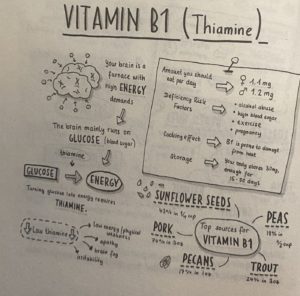
Vitamin B
B vitamins are a series of chemically related water-soluble vitamins. They are necessary to the whole body, but lack of them tends to appear first in nervous system functioning.
B1 (thiamine) is common in most foods, but much is lost when grain is milled. Thus, beriberi (thiamine deficiency, leading to neurological damage typically characterized by paralysis of the feet) is a polished rice and white flour disease. Flour is usually sold enriched today, with the major B vitamins put back in, but this is not universal. Enriched rice is, unfortunately, not the rule worldwide. Polished rice has only about half the thiamine of whole-grain rice; this has been a major problem in many rice-dependent areas.
Vitamin B2
B2 (riboflavin) is common in the same foods as other B vitamins and is rarely deficient. If it is deficient, the other B vitamins are, too, and probably several other nutrients. Thus, it may be passed over in silence here.
Vitamin B3
B3 (niacin), by contrast, is one of the world’s most serious vitamin problems. It is rather widespread in foods but is often milled out like thiamine (though to a lesser degree). The real problem is that it is chemically quite active as a base. It reacts with strong acids in foods (such as oxalic acid) to form compounds that human beings cannot digest.
The worst problem comes when the diet is rich in phytic acid, a strong acid found commonly in seed coatings, husks, and many leaves, especially where phosphorus is abundant in the soil. (The plants use the acid to store phosphorus.) The phytate radical of the acid bonds with the niacin. This is classically a problem with maize eaters because corn is low in niacin and high in phytate. Avitaminosis B3, known as pellagra, is thus called “a plague of corn.” It was common in the old South, Italy, Romania, and elsewhere. It is a serious danger in Africa and north China today, as maize becomes more important due to its high yields. One of the most unpleasant conditions imaginable is characterized by the “four D’s”: diarrhea, dermatitis, dementia, and death. Agonizing pain often accompanies mental deterioration.
Maize
The Mexican Indians found a trick that saved the pre-Columbian world from pellagra. To soften its hard kernels, they boiled maize with lime (calcium oxide, not the citrus fruit). This boiling process produces the familiar nixtamal of Latin America. The lime reacts with the acid and neutralizes it, saving the niacin and minerals. Wood ashes were used with the same effect in other areas, including the pre-Columbian and post-Columbian South of what is now the United States. Lye in the ashes neutralized the phytate.
In turn, Hard maize kernels were selected as a protection from weevils. In the American Southwest, weevils were not a major problem, so the Indians grew softer corn. This meant they were less prone to process the maize, though the Zuni did process it with alkali from alkaline springs, and other groups used wood ashes. Nutritional deficiencies had much to do with the fall of the great pueblos of the twelfth and thirteenth centuries. Some of these deficiencies may have been due to overmuch phytate in the maize, though there were also sheer food shortages, as drought affected an overused ecosystem.
Maize Served In Mexico
Recently, maize meal in Mexico has sometimes not been treated with lime, resulting in inferior tortillas and a resurgence of vitamin and mineral deficiency. I was told in Yucatan that this happened when a U.S. maize meal was imported or used in food aid. Today, major Mexican food processors carefully use lime to process their corn meal.
Both maize, wheat, soybeans, and many other seed foods are rich in phytate. Thus, people in areas with these important foods can only flourish if they have processing techniques that destroy the phytate. Leavening in bread does this. Yeasts metabolize the stuff and destroy it, so yeast-raised whole-grain wheat bread has half (or less) of the phytate of unleavened bread. Unleavened whole-grain bread is also associated with metal deficiencies, including zinc deficiency in Iraq because phytate takes up active metal ions. Making soybeans into tofu (bean curd), soy sauce, miso, etc., removes the phytate. Historically, soybeans did not become important until such processing technologies were established since the Chinese realized they were nutritionally inferior before processing to satisfy human nutritional needs. Soybeans have other serious problems (iodine-bonding chemicals, etc.) that processing reduces or eliminates.
B6
B6, B12, and other minor B vitamins are rarely diet deficient. An exception is folic acid (B9), a B vitamin necessary in large quantities for fetal development. As its name suggests, it is found abundantly in leaves, but it is also found in other fresh foods. It is thus common in natural foods. However, life on a modern processed diet often leads to deficiency, which in turn can lead to defects in neural tube development in the fetus, as well as other problems for all ages. It is estimated that as many as a third of the pregnant women in the world are deficient in folic acid. However, one serving of relatively vitamin-rich fruit or vegetables provides enough for human nutritional needs. Folic acid has become a major concern of maternal- and child health workers and advocates and is being widely distributed.
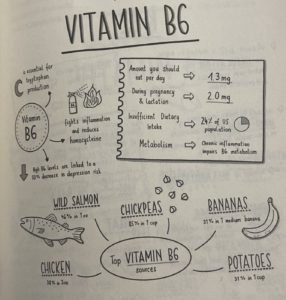
B12
B12 is necessary for iron metabolism, and lack of it causes anemia. This vitamin, more technically known as cyanocobalamine, can easily be deficient in vegans since it is not found in true vegetable foods. It is, however, found in fungi, especially yeasts. Brewer’s yeast is the richest source (though there is a controversy on how available the B12 in yeast is to human digestion).
Vegetarians have learned to sprinkle it on their food. In other cultures, they use various fermented products rich in yeast, such as soy sauce, south India’s sourdough foods, and, at least formerly, beer. Old-time beer was not strained and clarified as it is now; such processing eliminates most of the yeast. I have had rice beer in Malaysia that had to be eaten with a spoon. The rice mash was full of yeast. Some modern beers, sakes, and Chinese “wines” (which are brewed from grain) have a fair yeast content.
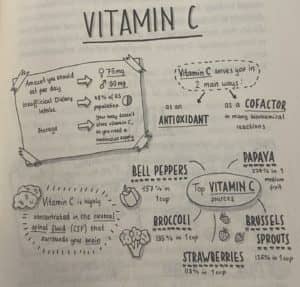
Vitamin C
Vitamin C is a special problem for higher primates. Most other organisms make their own metabolically. (Guinea pigs are among the few that do not, which is one reason they are so popular as lab animals in nutrition studies.) The ability to make vitamin C was probably lost because we were eating fruit and leaves, and primates who wasted metabolic effort doing unnecessary vitamin-making left slightly fewer descendants. In any case, the body uses up vitamin C stores fairly rapidly in a few weeks or months. Suppose no further vitamin C is taken in. In that case, the result is scurvy, once one of the most dreaded conditions. An inevitable corollary of long residence on shipboard or in jail.
Scurvy
Long winters led to scurvy in the days before modern transport made fresh food available. In human nutritional needs, vitamin C is necessary for all bodily processes. Scurvy is a breakdown of the whole bodily machine. Skin deteriorates; rashes, dry flakiness, and eventually, fissures and scaling patches develop. Wounds and illnesses don’t heal. Teeth loosen; gums deteriorate and develop painful sores.? A very painful death eventually supervenes.
The main sources of vitamin C are fresh plant materials. Those with the highest levels include the acerola or Barbados cherry, the lemon guava, green and red peppers, and certain other fruits. Rose hips from Rosa Rugosa are extremely high. Still, most other rose hips are not particularly rich in vitamin C. Grain and other dry foods are lacking in vitamin C. White potatoes are the only important starch staple that has it. Meat has a little in the blood (but not in the actual muscle tissue), and organ meats (especially the liver) can be high in vitamin C, but an animal diet is usually not an adequate source. Arctic people eat the stomach and intestinal contents of animals such as reindeer and survive.
Vitamin C is easily destroyed by oxidation, dissolved by water, and otherwise wiped out, so it is lost when food is dried, heated, pickled, boiled with the water thrown away, or destructively processed. Thus, people must have access to fresh foods. Before James Lind popularized the use of lime juice to prevent scurvy in the eighteenth century, ships often lost most of their crew on long voyages.
Vitamin D
Vitamin D is necessary for calcium metabolism, and deficiency causes bone problems (rickets or osteomalacia). Sources include sea animal livers. D is a fat-soluble vitamin like A. It is normally manufactured by the skin in the presence of ultraviolet light and thus is a dietary necessity only for people who live in foggy or long-night areas (e.g., the industrial slums of England in winter) or who live indoors all the time-especially dark-skinned people, since melanin blocks ultraviolet rays.
Veiling and seclusion of women in extreme Muslim countries like Libya leads to vitamin D deficiency. (Incidentally, veiling and seclusion of women is not Quranic or religiously enjoined by Islam; it is a habit picked up from Christian communities in the early centuries of Islam.) Vitamin D deficiency rickets in children and osteomalacia in adults characterized by weak bones. It has resurfaced as a problem in the United States owing to indoor lifestyles. It is correlated with some cancers and apparently with multiple sclerosis, leading to very high rates of multiple sclerosis in sun-short parts of the Pacific Northwest.
Vitamin E
This vitamin is necessary for most body functions but is so common. Vitamin E in such trace amounts is virtually never deficient in humans. Despite the dishonest claims of certain “health” food promoters.
Vitamin K
Specifically, vitamin K is necessary to produce the chemical that allows blood to clot. It, too, is rarely deficient. Both these vitamins are fat soluble.
Minerals
The human body needs at least fifteen mineral nutrients, but few are of broad anthropological interest. Things like vanadium and arsenic (the ultimate proof that many a necessity is poison in overdose) are needed in such small quantities (if at all) that they are picked up without anyone noticing.
As for the major mineral nutrients, phytic acid is again a problem. A fairly strong acid bonds tightly with the more chemically active metals. Thus, iron, calcium, zinc, copper, manganese, magnesium, and some minor metal nutrients are rendered undigestible and can even be pulled actively out of the body’s preexisting stores.
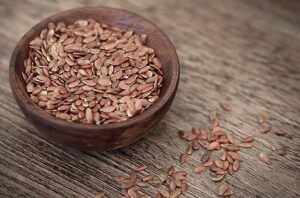
Iron
Iron is often deficient even without food phytate. It is necessary mainly for the chemicals in red blood cells that carry oxygen to the tissues. An iron deficiency causes anemia. Women are at particular risk since menstruation almost doubles the iron requirement, and pregnancy and childbirth triple it. Pregnant women require iron for their human nutritional needs in amounts surprising to patients. Thus, iron supplements are routinely supplied to expecting mothers. In traditional societies, iron was once supplied by an omnivorous diet high in small animals, fish, leaves, and the like. The shift to grain agriculture and the rise of dense, impoverished populations have been devastating.
Today, it is estimated that over 80% of women of childbearing age in India are anemic. Indian spices are often high in iron, one reason for the spicy Indian diet: people learned early that spices prevent the weakness and pallor we now know as anemia. But most women in India have trouble affording much spice or, indeed, affording anything beyond minimal grain staples.
Iron As A Mineral From Natural Sources
The main iron source for most people is vegetable tissue, with leaves being a rich source—but this is precisely the area where oxalic, phytic, and other acids are a problem. Even without them, iron is hard to digest unless already in animal tissues. Humans can absorb only a small percentage (as low as 2%) of the iron in vegetable sources. Thus, meat and especially blood and liver are valuable. Billions of people survive without much animal protein but tend to get anemia, especially if they are women of reproductive age.
Conversely, too much iron is also a bad thing. The level of supplementation needed by a woman for childbirth is potentially dangerous for an old man. This has led to a major worldwide controversy over whether to begin iron supplementation of common foods. Currently, it is not done. All women hoping for safe reproduction require iron pills.
Calcium
Another problematic active metal is calcium, which is necessary in enormous quantities for bone growth but (like iron and most other metal nutrients) is potentially dangerous in overdose. Calcium deficiency is one cause of osteoporosis- bone deterioration with age- which is common among the elderly, especially among women who have not exercised much and who did not build up good bone mass in their youth.
Calcium, too, is subject to blotting up by phytic acid, as noted above. Moreover, the diet must balance it with magnesium, potassium, and phosphorus for proper nerve function and bone growth.
This complicates calcium in the daily amount of nutrition needed. Authorities can reach opposite conclusions. Ancestral humans ate little calcium, and we are now eating too much. Some early human nutritional needs required eating very little calcium. So both of them may be right, for different people at different times. Many children now get too little calcium, too little sunlight, and thus too little vitamin D. Rickets is a condition that has returned as a condition in our cities.
Salt
Salt-sodium chloride is necessary for human life. Concentrating in only a few spots (outside of the ocean) is a major stimulus for trade. Many traditional groups were forced to produce all sorts of valuables to obtain this vital need. Salt loss often causes death among people working or traveling in the hot sun. This gave Death Valley its name; ironically, the explorers in question died among salt-rich plants, and any local indigenous person could have told them they could have saved their lives by browsing a bit. They didn’t ask.
Salt is yet another nutrient that is dangerous in overdose. At least in genetically susceptible individuals (apparently, a large percentage of humanity, and some other primates, are at least somewhat susceptible), it brings on high blood pressure. lodine is another problem, deficient in many of the world’s soils. Iodine is needed in only one of the body’s chemicals: thyroxin. However, this is a critical compound; the hormone secreted by the thyroid gland regulates growth, including brain growth.
Marine products (sea salt, seafood, and especially seaweeds) are good sources, but people far from the sea often suffer. Cretinism-mental and physical deficiencies caused by iodine deficiency-seriously affected a third of the population. Iodized salt has eliminated iodine deficiency in most areas, but junk food and processed food tend to use non-iodized salt, and the problem is cropping up again.
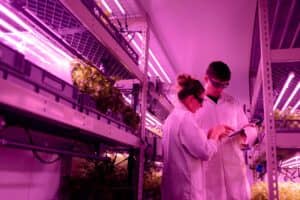
Fine-Tuning: Special Needs and Nutrients
Males and postmenopausal women are more at risk for heart disease than reproductive-age women because estrogen is a protector of atherosclerosis. Many plants, notably beans, contain estrogen-like chemicals, which may lower the heart disease rate. High soybean consumption, for example, is associated with low heart disease incidence.
The danger of saturated fat was established in cross-cultural epidemiological research by Ancel Keys in the 1950s. Initial fears that cholesterol consumption would lead to too high a blood cholesterol level have not been supported by evidence. The body handles cholesterol perfectly well; certain saturated fats are the problem. Hydrogenated vegetable oil-margarine and the like— is significantly worse than any natural saturated fat. The “trans” fats created by hydrogenation seem genuinely damaging to the heart. Following this finding, American snack firms and fast-food chains have sharply reduced their previously heavy use of hydrogenated oils.
Some foods, like coconut, have almost exclusively saturated fatty acids. Others, like peanuts, have roughly equal amounts of saturated, monounsaturated, and polyunsaturated oils. Finally, such oils as safflower are almost entirely polyunsaturated. There is a weakly supported claim that polyunsaturated oils are better for the heart than monounsaturated oils. However, people who eat great amounts of monounsaturated oils tend to live long and stay healthy. This is most famously true of Mediterranean inhabitants; olive oil may be special. In Keys’s studies, South Italians and Greeks-olive oil eaters were heart-healthy much longer than North Italians, to say nothing of Dutch and Finns. Even coconut-eating groups live relatively long and healthy lives, a point that needs more research.

Mediterranean Diet
The Mediterranean diet is also rich in flavonoids (in particular, carotenes), now known to be associated with resistance to cancer and heart disease. The “Mediterranean” diet is high in fish, beans, vegetables, fruits, and slow-to-digest carbohydrate foods such as pasta. People from Mediterranean countries are fond of pointing out that there is no one Mediterranean diet. North Italians point out (at times somewhat ruefully) that they eat a great deal of red meat, butter, white bread, and other foods that are the antithesis of what outsiders love to call “Mediterranean.” Red wine has proved to be good for the heart. It probably prevents cancer, and indeed, very moderate alcohol consumption (one ordinary drink a day) is associated with better health and longer life. However, the advantages of resveratrol, an antioxidant found in red wine and red grape juice, have been greatly exaggerated in the media owing to some shaky claims.
Oat bran and other sources of soluble fiber, including beans, lower blood cholesterol; oat bran and beans do better than either separately. Oat bran became a fad a few years ago but was added to muffins and cereal in such minute amounts that no one benefited much. However, adding bulk oat bran to homemade bread provides enough to make a difference.
Base Foods Of The Mediterranean Diet
Fatty fish are rich in omega-3 fatty acids, which protect against cholesterol buildup. Polynesians eat a lot of fatty fish:
- Bonito
- Mackerel
- Scad
Similar fish protect Arctic and Northwest Coast natives in North America. Seals, whales, salmon, smelts, and other common foods of the North are rich in omega-3 fats.
Heart disease is rare. The basic omega-3 fatty acid, linolenic acid, makes little if any difference; other omega-3s seem to be the ones that count. Other foods, including island vegetables and fruits, may also have a piece of the action. Factors at work could also include stress and lack of exercise in New Zealand.
There is much to learn about the value of greens in general. Other foods will no doubt prove valuable. Yogurt has been rather equivocally implicated in lowered heart disease incidence. Walnut and pecan consumption reduces heart disease risk owing to the high omega-3 levels in their oil. One controlled study found that daily consumption of these nuts was accompanied by heart disease incidence a striking 50% lower than in comparable non-consumers (Joan Sabate, personal communication, 2000) It is only fair to note that Dr. Sabates study was supported in part, by walnut growers. Other nuts seem to have similar effects on human nutritional needs. Many other traditional and favored human foods probably work.
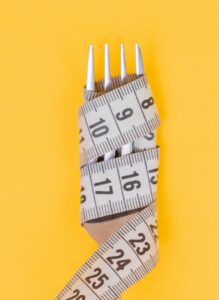
Human Nutritional Needs For Individuals With Diabetes
Diabetes, untreated usually brings about death from heart or kidney failure. The rapid change from the almost sugarless diet of Polynesia to the sweets-loving world of New Zealand is a shock to the system. Polynesians are rather susceptible, genetically, to type 2 diabetes. As are Native Americans, Native Siberians, and many other traditional rural peoples of the world.
The Akimel Oodham and Tohono Oodham (the peoples that European settlers called Pima and Papago) of Arizona were virtually free from diabetes until two generations ago. Before the twentieth century, they had lived on desert foods such as mesquite meal, wild greens, cactus buds, and fruits and on traditional crops: maize, locally grown wheat, beans, squash, and chiles. In the late nineteenth and early twentieth centuries, they lost most of their land and almost all the water needed to irrigate what land they kept.
After World War II, they were progressively incorporated into the wider society of Arizona. This led to the expected dietary changes. Alcoholism, previously very rare, become more common. Sugar and white flour replaced traditional foods. Today, most adults suffer from diabetes, and life expectancy is falling as the disease extracts its dreadful toll on heart and kidney failure and necrosis. Return to a traditional diet reverses much of this but is difficult to effect.
The Tohono Oodham in Mexico were slower to change, but they are rapidly catching up. This may presage a vast disaster in Mexico, where most of the population has considerable Native American ancestry. Already, diabetes has become common among the more prosperous of the Maya of the Yucatan Peninsula. It is spreading in other groups as well.
Alcohol
This introduces the subject of alcohol. Alcohol, in large doses, is a deadly poison. Death from alcohol poisoning is common. Death is also not infrequent among alcoholics forced to go “cold turkey.” Withdrawal from physical addiction to alcohol is extremely harsh. (We are not talking about a “drinking problem” of two beers a night here; we are talking a pint of vodka a day.)
Heavy drinking, even without addiction, is associated with heart disease, cancer (alcohol is quite carcinogenic), and much else. However, small amounts of red wine (a small glass per day, best taken with food) protect against heart disease, and apparently, white wine and beer do some good. This is not so much because of the alcohol as because of various tannins and other compounds in the wine and beer. What the British call “real” beer and what the Americans call “microbrewery” beer is better than the ordinary mass-produced brew, which has little besides alcohol and water.
Cancer And The Connection To Sugar
Proneness to cancer also varies with heredity, but it, too, is manipulable by diet. Antioxidant vitamins A, C, and E destroy many carcinogens and are thus a good thing to eat in quantity. Tomatoes, cooked, appear to act against prostate cancer, mostly by keeping up the lycopene levels in the prostate; lycopene is concentrated in tomatoes and prostates, a rather odd pair.
This is a healthy sign; for a long time, it seemed that more and more foods were turning out to cause cancer. By the 198os, people were saying, “Everything causes cancer,” and thus were not bothering to avoid the very few things that are risks. No common foods are serious carcinogens in the class of tobacco and alcohol. Nitrosamines in poorly salted fish appear to cause nasopharyngeal cancer. Nitrosamines in grilled meat, soy sauce, and other food products have been implicated by association with various cancers but do not appear to pose much risk.
One potentially very serious risk is aflatoxin in spoiled peanuts and similar products. Some aflatoxins are extremely prone to cause liver cancer. But no one eats spoiled peanuts voluntarily, and the tiny amounts of aflatoxin in foods like peanut butter present minimal risk. There are tiny amounts of toxins in many common foods, such as parsnips and arugula, and in many herbs, such as sage and comfrey. No one eats a bushel of parsnips a day.
Poison
The extent of poisons in natural foods has been exaggerated in some quarters. Especially by people who argue in favor of using artificial additives or allowing pollution, claiming that nature is full of poisons already. First, this argument is justified if the additives are safe (most are), but people are usually good at detoxifying the few natural but somewhat toxic things they eat. Second, if the claim were true, we should be more careful about pollution, not less. The precautionary principle-“first, not harm,” as Hippocrates put it- tells us we should still minimize the risk. More to the point, we can voluntarily abstain from parsnips (indeed, most of us do), but we usually have the pollution dumped on us whether we want it.
Food Coloring And Pesticides
Long life is gained through eating a varied diet rich in high-fiber vegetables, including those trivially “toxic” ones. Long life is not gained through living in a polluted environment. Pesticides, hormones, artificial coloring, and flavoring agents add little at best; we do not need them in the food supply. Feeding antibiotics to livestock, for instance, has led to the evolution of bacterial strains that resist a very wide spectrum of antibiotics and are, therefore, a huge danger to those already at risk from a host of drug-resistant pathogens. McDonald’s has now stopped buying antibiotic-fed beef.
Mediterranean people live long, healthy lives, even under harsh circumstances. They lived on bread, yogurt, and olive oil. The Mediterranean diet is generally based on heavy consumption of grains (often whole grains), fruits, and vegetables. Along with olive oil as the fat source and most animal protein from fish or yogurt. Cheese and meat are allowed in small quantities. They are reviving their traditional diet, but other groups find themselves in city slums, eroded farmlands, or other environments where the chance is lost.
Antioxidants
Carotene-rich vegetables, especially those of the cabbage family, are uniformly and consistently associated with longer life and lower heart disease and cancer incidences. So are onions and garlic, though these do not lower cholesterol. Berries, especially strawberries, raspberries, blueberries, and pomegranates (technically berries), are quite suggestively linked.
Antioxidants, as well as many and varied chemicals that blot up free radicals, are given credit. Most intriguing is a recent finding that brains age better in lab rats who eat blueberries. Senile dementia is lessened and delayed. Of course, no one particularly wants brainier rats, but the hope is that this generalizes to humans. At worst, it provides a good excuse for eating blueberries. Some tropical berries are richer in antioxidants and have sparked fads in health stores and juice stands.
They may or may not become permanent parts of our diet. Açaí berries (a Brazilian palm fruit) seem here to stay, though their contribution to health is not strictly proven. On the one hand, the European Food Safety Authority casts a dubious eye on them. On the other, the ordinary eater is well advised to eat them in quantity, since the benefits could be extremely high and certainly greater than the small costs of most foods.
Odder nutraceuticals (medical foods) have been consumed. Beer in Nubia in ancient times was antibiotic because the starter for the mix of yeasts and fungi used to ferment included microorganisms that produced tetracycline. Residue analyses showed enough in the beer to treat infectious diseases in the drinkers.
Where Are People Living The Longest
Several areas of the world have been claimed as “long-life” areas. Dan Georgakas, in a delightful book called The Methuselah Factor (1980). This book debunked several of the claims in question. The Hunza of northern Pakistan gained a reputation for health because no one saw sick people among them. They kept their sick indoors- the climate was fierce.
When a medical doctor visited Hunza, he found as much sickness and early death as one would expect in that part of the world. The long-life claims of the Abkhazians, the people of Vilcabamba in Ecuador, and many other communities have been similarly debunked. It seems they were prone to showing visitors their grandparents’ birth records. Names are often recycled for two or three generations in those areas. Long-life tourism has become significant in local income.
Longevity Research From Stephen Simpson and David Raubenheimer
Yet another dubious claim is that starving yourself will make you live longer. It has been known since Hippocrates and Galen that eating too much was dangerous. It is from newer claims that yeasts, fruit flies, mice, monkeys, and people live longer. If they not only avoid obesity but cut calories to famine levels. In a recent review of biology and the right amount of nutrition by Stephen Simpson and David Raubenheimer, this claim is cut down to size. The yeasts and fruit flies did better when given their favorite ratio of protein to carbohydrates. The mouse and monkey experiments compared lab animals fed ad-lib and given little if any, exercise with animals given a normal lifestyle. In other words, couch potatoes were compared with active outdoors individuals.
Simpson and Raubenheimer point out that humans aim for a 15% protein intake (no special ratio to carbs), but with a diet of processed fast food, they rarely get it (fast food runs to carbs and oil); so part of modern obesity is a desperate striving to get enough protein to make a balanced diet, or at least to get enough protein to stay healthy. Simpson and Raubenheimer also emphasize the effects of exercise: reducing exercise not only means that the same amount of food suddenly starts making us fat but also reduces the beneficial metabolic effects of exercise.
Longevity In Non-Human Animals
Calorie restriction lengthens the life of worms and flies, but it does not seem to help in mammals. Unless they are being fed too much. Mice lived longer when fed less, perhaps because they had been eating too much lab chow and not necessarily the best. Monkeys do not live longer or better on a restricted diet unless they eat too much lab chow. Self-starvation seems unnecessary.
One may note, also, the recent attention paid to southwest France, the longest-lived part of the Western world. The area’s people eat much butter, cheese, and paté, so there are claims that such foods are “not so bad.” The truth, however, is that the southwest French lived hard lives when the current oldsters were growing up. Diet ran heavily on whole grains and fresh vegetables. The exercise was inevitable for most and came in the form of sixteen-hour days of labor on the peasant farm. Only the richest could afford the meat or butter to get the nutrients for our human nutritional needs. It was under those harsh circumstances that they developed their toughness. We can predict that the current generation, raised on butter and cream, will live shorter lives for it.
Eating For A Strong Immune System
Elie Metchnikoff, the elucidator of the immune system, noted that Bulgarians lived long, even in the bad old days when poverty and disease were rampant. He ascribed this to yogurt. He was partly right, but we now would add their fondness for fresh vegetables and fruits and their poverty-forced abstinence from meat, sugar, and cheese. His enormous prestige as a scientist gave him all appearances of authority, and yogurt rapidly gained popularity. Previously unknown in the English-speaking world, it became increasingly popular as a health food, especially after 1950. It is still with us, in every store and market in the United States and now even in urban China, an amazing tribute to the ability of one man to change world foodways.
Longevity In Japan
Japan is the longest-lived country in the world (along with Iceland), and its longest-lived people are found in interior mountain villages. Living in the mountains gives people more exercise in the terrain. The diet is (or recently was) largely raw and brown rice, fresh vegetables, and soybeans.
Longevity In China
South China has some similar but slightly less longevous villages, notably among Kwangsi’s Zhuang (Thai-speaking) people. Studies in China in the 1980s by T. Colin Campbell and associates showed astonishing freedom from degenerative diseases. Heart and circulatory diseases and diabetes hardly existed. Most cancers were rare. The diet of grains that were not highly milled, along with many varied vegetables, bean curd, and little else, was healthy and protective. Antioxidants were high.
Campbell does not mention it, but one reason is the traditional Chinese use of antioxidant-rich vegetables and fruits as medicinal foods. Meat, fat, sugar, alcohol, and highly processed starches were conspicuously absent from everyday diets. Cholesterol levels averaged 127 milligrams/deciliter, as opposed to over 200 in the United States today. This may have contributed to some cancers, and so did the limited and often polluted diet. Overall, people got their human nutritional needs met and were healthy and long-lived if they survived the frequent infantile diseases. Calorie consumption was low, associated with long life in all animals from worms to monkeys, and presumably in humans, too —but only if they ate too richly before restriction.
Foods To Avoid
Unfortunately, and ironically, economic growth and improving life have proven deadly. As we have seen, people love fats and sweets, and affluence allows them to enjoy them. Heart disease, stroke, and diabetes have soared. The vast strides China made in the twentieth century through fighting poverty, malnutrition, and infectious disease have suddenly stopped as degenerative diseases increase.
This is a worldwide story. Developing countries have become major growth areas for such conditions, especially obesity and diabetes. New evidence suggests that dementia can show symptoms earlier from poor foodways. Oppositely, symptoms can be postponed by vitamin and antioxidant-rich foods. The problem with getting your basic human nutritional needs is usually a dramatic lifestyle change. Affluence is part of it, but commoner and perhaps more tragic is the case in which affluence has not much increased but lifestyles have changed for both rich and poor in the direction of less exercise and worse food. Urbanization, mechanization, and so on have reduced activity even for the working classes.
Meanwhile, if you want to live long, remember that reasonable exercise is at least as valuable as food. Psychological well-being is a valuable part of your relationships. Dedicate your life to good people and causes. Food isn’t everything. But feeding your human nutritional needs is.


